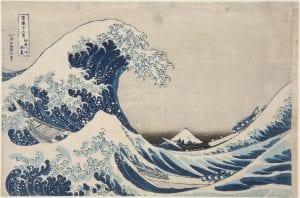Kitagawa Utamaro Collection
His Five Women or Five Women Around Utamaro (歌麿をめぐる五人の女 Hepburn: Utamaro o meguru gonin no onna)
Utamaro and His Five Women or Five Women Around Utamaro (歌麿をめぐる五人の女 Hepburn: Utamaro o meguru gonin no onna) is a 1946 Japanese film directed by Kenji Mizoguchi. It is based on the novel of the same title by Kanji Kunieda, itself a fictionalized account of the life of printmaker Kitagawa Utamaro. It was Mizoguchi's first film made under the American occupation.
The story is set in Edo (now Tōkyō) in Japan.
The film starts with a parade of samurai and their concubines (oiran, distinguished by their high shoes) along an avenue of cherry trees. Koide, called Seinosuke by his woman Yukie (Kotaro Bando), an artist/samurai apprenticed to a Kanō master, leaves the parade and visits a print shop where he sees a woodcut print by Utamaro that boasts of ukiyo-e 's superiority to the official style. Enraged, he goes to a tea-house to find Tsutaya Jūzaburō, the owner of the print shop, to express his displeasure. Word is leaked to Utamaro to avoid the tea-shop, but instead he goes there directly to investigate. Koide then challenges him to a duel. Utamaro counter-challenges him with a different kind of duel––a painting contest. [1]
Utamaro is declared the winner by Koide, who then acknowledges Utamaro's superiority. Koide then follows Utamaro as a disciple.
We then hear that Edo's best tattoo artist lacks the confidence to draw on the back of a famously beautiful courtesan, Orui. Utamaro asks her permission to paint directly onto her back (for the tattoo artist to then tattoo over). She is proud to accept. Shozaburo falls in love with Orui and elopes with her to the countryside, leaving behind his fiancee, Okita.
Utamaro goes to a lake-side with his friends and spies Oman, the beautiful daughter of a commoner, amongst a whole group of bathing girls. He takes her to be his long-term model.
Upsetting the magistrates with some of his prints, he is sentenced to be handcuffed for 50 days.
Okita tracks them down and brings Shozaburo back to Edo, but later discovers he is still seeing Orui and stabs him in front of her, then kills Orui. Okita then goes to Utamaro's house to await her fate, knowing she will be executed for the crime, but explaining that she had to be true to her own feelings.
At the final scene, Utamaro's handcuffs are removed and he instantly returns to drawing. The film ends with a collection of his most famous prints falling one by one in front of the camera.
Follow this version for english subtitles;
https://m.youtube.com/watch?v=TThwphS-3oQ
Full version below (not english)



